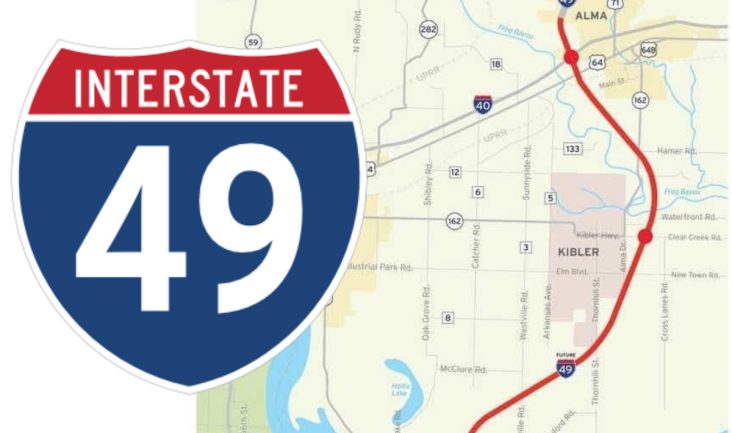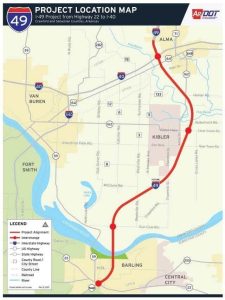Feds award $25 million grant for I-49 segment in the Fort Smith metro
by June 27, 2024 4:14 pm 2,935 views

The almost 14-mile segment of Interstate 49 to be built in Crawford and Sebastian counties between I-40 in Alma and Highway 22 in Barling has received a $25 million federal grant and is in the running for another $250 million federal grant.
The Arkansas Department of Transportation (ARDOT) said Thursday (June 27) that the U.S. Department of Transportation awarded a $25 million Rebuilding American Infrastructure with Sustainability and Equity (RAISE) grant for use on the I-49 segment. The money comes from the $1.2 trillion Infrastructure Investment and Jobs Act or Bipartisan Infrastructure Law. No members of Arkansas’ Congressional delegation voted for the legislation.
“After decades of underinvestment, the condition of America’s infrastructure is now finally getting better instead of worse – and today we proudly announce our support for 148 more projects in communities of every size across the country,” U.S. Transportation Secretary Pete Buttigieg said in a statement. “Through President Biden’s Bipartisan Infrastructure Law, we’re funding projects across the country to make roads safer, make it easier for people to move around their community, make transportation infrastructure more resilient to extreme weather, and improve supply chains to keep costs down for consumers.”
State officials in October 2022 ceremonially broke ground on the 13.7-mile segment that will connect a segment of I-49 in Barling north to the I-40 interchange in Alma. That section will include a bridge over the Arkansas River and have interchanges at Highway 22, Gun Club Road, Clear Creek Road and I-40. The bridge across the Arkansas River will be east of Trimble Lock & Dam and the U.S. 59 bridge. Highway officials estimate the segment could cost up to $1 billion to complete. Information in the RAISE application pegs the cost at $1.26 billion.
Arkansas highway officials estimated in early 2022 that it would cost $4.1 billion to complete 136 miles of I-49 from Fort Smith to the Texas state line.
Jared Wiley, ARDOT chief engineer for pre-construction, has said bids for construction could be let late this year or early next year, with work beginning in the summer of 2025. The work would begin in Barling and move north toward the I-40 interchange. He said the segment could be completed in 10 years.

Arkansas Highway Commissioner Keith Gibson, who lives in the Fort Smith metro, praised U.S. Sen. John Boozman, R-Ark., and U.S. Rep. Steve Womack, R-Rogers, for their work to secure federal funding for infrastructure projects in the region.
“I-49 is a critical artery to our state and nation. Investments in this corridor will help ensure we are more connected while strengthening economic growth and development,” Boozman said in a statement provided by ARDOT. “I’m pleased to support the RAISE grant and advocate for infrastructure improvements in Arkansas communities.”
Gibson said a $250 million grant through a multi-modal program was rejected in the previous cycle, but he is “very, very optimistic” about receiving it in the next round “because of Senator Boozman’s effort leading that.”
“I am so grateful for Congressman Womack. He and Senator Boozman are both working really hard to get the money we need to complete that (I-49),” Gibson said.
In addition to the I-49 work, Arkansas also received the following RAISE grants.
• $11.566 million: Siloam Springs
This project will fund the planning, engineering design, and construction of street improvements along East Main Street between Maxwell Street and Lincoln Street. The project includes replacing the Sager Creek Bridge, pavement resurfacing, bicycle lanes, ADA sidewalks, lighting, street trees, traffic management solutions, stormwater drainage, and utilities.
• $4.222 million: Searcy
This project will plan and design approximately 15.5 miles of greenway linking Kensett to downtown Searcy as an expansion to the existing 5.5-mile Searcy Bike Trail. The project will include three components: 1) revising citywide plans, policies, and ordinances to incorporate the planned greenway, 2) collecting public input, and 3) the completion of design and construction documents.
